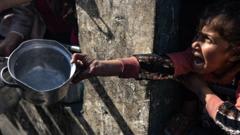The Ripple Effects of Global Aid Cuts: A Looming Humanitarian Crisis
 The Tech Times
The Tech Times
In a world where the balance of aid can mean the difference between life and death for millions, recent reports have highlighted the potentially catastrophic impact of proposed U.S. aid cuts on global health. A stark warning from the esteemed medical journal, The Lancet, suggests that these cuts could lead to the deaths of 14 million people over the next five years, including 700,000 children annually. As discussions continue about the implications of these cuts, it is essential to contextualize this issue within a broader historical framework and understand the potential consequences.
Historical Context: Aid as a Lifeline
International aid has long been a cornerstone of global diplomacy and humanitarian efforts. Post-World War II, the establishment of organizations like the United Nations and the Bretton Woods institutions underscored a collective international commitment to rebuilding and supporting nations in need. Over the decades, foreign aid has played a crucial role in addressing health crises, poverty, and instability across the globe.
In particular, U.S. foreign aid has been instrumental in funding health initiatives that have dramatically reduced mortality rates and improved quality of life in developing countries. For instance, the President's Emergency Plan for AIDS Relief (PEPFAR), launched in 2003, has been credited with saving over 20 million lives by providing antiretroviral treatment to millions of people living with HIV/AIDS. Such programs underscore the critical role of sustained foreign aid in combating global health challenges.
The Potential Impact of Aid Reductions
The proposed cuts to U.S. foreign aid, as highlighted by The Lancet, pose a significant threat to ongoing health initiatives worldwide. These reductions threaten to reverse years of progress made in fighting preventable diseases and improving healthcare access in under-resourced regions.
The anticipated impacts are manifold. Firstly, reduced funding could severely undermine efforts to combat infectious diseases such as malaria, tuberculosis, and HIV/AIDS. These diseases require consistent financial investments for prevention, treatment, and research efforts, which are paramount to keeping infection rates in check.
Secondly, child mortality, which has seen a significant decline globally due to concerted international efforts, could rise sharply. The Lancet's projection of 700,000 additional child deaths annually paints a grim picture of a future where preventable childhood diseases could once again become rampant.
A Call to Action
The potential humanitarian crisis necessitates urgent dialogue and action. It is crucial for policymakers, international organizations, and civil society to advocate for the continuation and even expansion of foreign aid programs. The argument for maintaining aid is not merely a moral one; it is also pragmatic. Healthier populations contribute to global stability and economic growth, ultimately creating a safer and more prosperous world for all.
Furthermore, the global community must explore innovative funding mechanisms to sustain and enhance these critical programs. Public-private partnerships, increased contributions from other nations, and the mobilization of resources from philanthropic organizations can help bridge potential funding gaps.
Conclusion
As the world stands on the brink of a potential humanitarian crisis precipitated by proposed U.S. aid cuts, it is imperative to remember the historical significance and life-saving impact of international aid. The grim projections serve as a clarion call for concerted global action to prevent a backslide in health and development achievements. The stakes are high, and the cost of inaction could be measured in millions of lives.
In navigating this complex issue, the international community must reaffirm its commitment to global solidarity and ensure that aid remains a lifeline for those who need it most.
Source: Trump global aid cuts risk 14 million deaths in five years, report says
Subscribe to my newsletter
Read articles from The Tech Times directly inside your inbox. Subscribe to the newsletter, and don't miss out.
Written by
